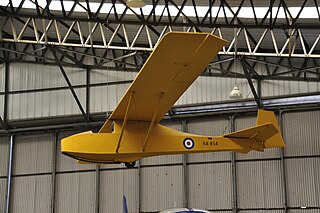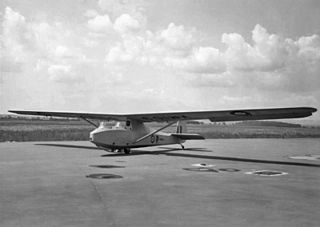
The Slingsby Hengist was a British military glider designed and built by Slingsby Sailplanes Ltd. Like other British troop carrying gliders in the Second World War, it was named after military figures whose name began with H, in this case the Jute invader Hengist.

The Slingsby T.38 Grasshopper is a British primary training glider built by Slingsby Sailplanes for the Royal Air Force.

The Baynes Bat was an experimental glider of the Second World War, designed by L. E. Baynes. It was used to test the tailless design that he had suggested as a means to convert tanks into temporary gliders so they could be flown into battle.

The G103 Twin II is a high-performance two-seat sailplane manufactured in Germany by Grob Aircraft. The aircraft is of T-tail configuration, and is fitted with upper-surface airbrakes and a non-retractable undercarriage. Of fiberglass construction, it is designed for training, high performance cross-country racing and simple aerobatic flying.

The Schneider Grunau Baby was a single-seat sailplane first built in Germany in 1931, with some 6,000 examples constructed in some 20 countries. It was relatively easy to build from plans, it flew well, and the aircraft was strong enough to handle mild aerobatics and the occasional hard landing. When the Baby first appeared, it was accepted wisdom that the pilot should feel as much unimpeded airflow as possible, to better sense rising and falling currents of air and temperature changes etc.

The Slingsby T.7 Kirby Cadet is a British training glider designed and built by Slingsby that first flew in 1935 and saw service with the Royal Air Force for use by the Air Training Corps as the Cadet TX.1 throughout the 1950, 1960s and 1970s.

The T.31 Tandem Tutor is a British military training glider, designed and built by Slingsby and used in large numbers by the Air Training Corps between 1951 and 1986.

The Slingsby T.21 is an open-cockpit, side-by-side two-seat glider, built by Slingsby Sailplanes Ltd and first flown in 1944. It was widely used by the Royal Air Force, Sri Lanka Air Force and by civilian gliding clubs.

The Slingsby Type 61 Falke was a licence-built version of the Scheibe SF 25B Motor glider built by Slingsby Sailplanes. It entered service with the Royal Air Force for air cadet training as the Slingsby Venture.
The Slingsby T.9 King Kite is a British glider designed and built by Slingsby that first flew in 1937.
The Slingsby T.20 was a British glider designed and built by Slingsby that first flew in 1944.

The Slingsby Type 42 Eagle was a two-seat glider designed in England from 1952.

The Slingsby T.3 Primary was a single-seat training glider produced in the 1930s by Fred Slingsby in Kirbymoorside, Yorkshire.

The Slingsby T.6/T.23 Kirby Kite was a single-seat sport glider produced from 1935, by Fred Slingsby in Kirbymoorside, Yorkshire.

The Slingsby Type 51 Dart is a single seat competition glider designed in the early 1960s, initially as a 15 m span Standard Class aircraft but evolved into an Open Class, 17 m sailplane. It was the last Slingsby sailplane to be mostly constructed of wood.

The Slingsby T.30 Prefect is a 1948 British modernisation of the 1932 single-seat Grunau Baby glider. About 53 were built for civil and military training purposes.

The Slingsby Type 45 Swallow was designed as a club sailplane of reasonable performance and price. One of the most successful of Slingsby's gliders in sales terms, over 100 had been built when production was ended by a 1968 factory fire.

The Slingsby T.24 Falcon 4 was a two-seat training glider designed in the UK just after World War II for ATC use. It was judged too expensive for production and only three were completed.
The Cloudcraft Phantom was a glider designed in the United Kingdom in 1931 to make long flights. It set an unofficial duration British record but vandalism prevented a cross-Channel attempt.
The Moore Gypsy or Birmingham Guild BG 100/12 and BG 135 is an early all-metal single-seat glider designed in the UK in the late 1960s. Several longer span variants were produced by various manufacturers. The first BG 135 was still flying in 2011.
















